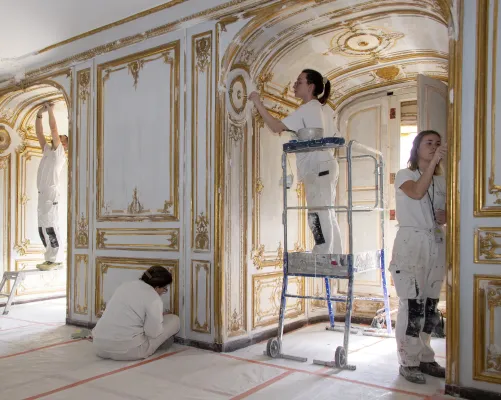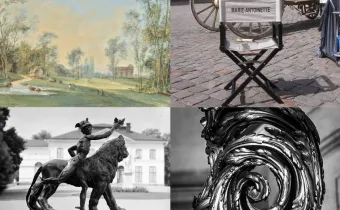A much-needed restoration
Madame du Barry’s apartment had been overlooked by restoration campaigns for over seventy years. It was last restored from 1943 to 1947, when it was returned to the layout Madame du Barry would have enjoyed back in 1770.
During this period, the paintwork had aged and warped, and the décors and ceilings had suffered from humidity and intense temperatures changes, resulting in the rooms ageing at rapid pace. The current campaign of works segues on from the 1940s, with most work aiming to achieve an identical restoration, merely correcting a few inconsistencies that arose in the previous campaign. These works are intended to plunge visitors into the refined, intimate atmosphere that these rooms would have once exuded, in a quintessential expression of 18th-century art de vivre.
Project progress
Works kicked off in February 2021, with some of the panelling and parquet partially removed, thereby enabling the teams to conduct the structural consolidation needed and build in the lighting and security networks. Alongside this, insulation work was carried out on the attics and lower slopes of the rooves to improve the apartment’s energy efficiency.
Following a few touch-ups on the woodwork sculptures and replaced panels, the old gilding has now been cleaned, restored and enriched in the apartment’s main rooms. The “regal white” glue-size painting was also marked out and refreshed using traditional techniques.
Finally, major works were carried out on the rooms adorned with colourful décors: rare and precious testimonies to 18th-century tastes. The stucco cornices were restored and filled in, and research was carried out to determine the shades to be used for the motifs, based on surveys of the panelling. Painters are currently working on recolouring the décors.
The restoration work is being carried out in compliance with 18th-century techniques employed by highly proficient skilled tradesmen and tradeswomen specialising in masonry, plastering, fine joinery and woodworking, marble working, metalsmithing and bronze working, decorative painting, gilding, and electrics.
refurnishing
Alongside the architectural restoration work, the apartment is to be refurnished by the Palace of Versailles conservation team in order to recreate the layout and feel that existed in Madame du Barry’s day.
Epitomising the pinnacle of 18th-century refinement, the furniture that would have stood here in 1770 is now scattered around the world. In its absence, the apartment is being refurnished with pieces from the Palace of Versailles’ collections that would have been used around Madame du Barry’s time, and which are best placed to recreate the surroundings that Louis XV’s mistress once would have enjoyed. Thus, alongside a handful of pieces commissioned for Madame du Barry (the corner cabinet chairs, a pietre dure table, a porcelain dinner service embellished with a blue ribbon design), furniture and items from the archives will be dusted off to enhance the overall sense of cohesiveness. New textiles will also be woven, including green damask curtains and door curtains in the dining room, and upholstery for the seating in the corner cabinet.
A refined, intimate space
In 1770, the widowed Louis XV decided to lodge his mistress, the Countess du Barry, within the palace walls on the floor above his own private apartment.
Designed by Ange-Jacques Gabriel, the apartment assigned to the royal mistress spanned over 350 m2 on the palace’s second floor. Its reception rooms (corner drawing room, grand cabinet, bedchamber) gave out onto the Marble Courtyard, while the more private rooms (library, dining room, ‘buffet’ room, bathroom, service rooms) gazed out over the inner courtyards. The apartment was dotted with access points that allowed the King to visit his mistress using a network of private staircases.
On Madame du Barry’s request, the main rooms were decorated in white and gold – the privilege of princes. The other half of the apartment boasted a dazzling collection of multi-coloured décor, rare and invaluable witnesses to 18th-century tastes, few of which still remain today.
Far from the spectacle of court, the mistress’ extraordinary refinement shines through here in these private spaces she decorated with fashionable furniture and art.
Madame du Barry only ever lived in this apartment for four years, from 1770 to 1774, when she was banished from court upon Louis XV’s death.
Upon her departure, the apartment was divided up, with only a few small changes made to the layouts. The spaces were then continuously occupied, allowing the apartment to elude the revolutionaries and their campaigns to disfigure all symbols of the monarchy in October 1793, and ensuring it retained a couple of its original double ‘L’s and fleur-de-lis on the fireplaces and woodwork. The apartment was also spared the in-depth changes to the Palace that Louis-Philippe brought about in the 19th century.
Madame du Barry
Jeanne Bécu, known as ‘Mademoiselle Vaubernier’, was born on 19 August 1743.
A countess by marriage, Madame du Barry followed in Madame de Pompadour’s footsteps to become Louis XV’s royal mistress after being presented to the King in 1768.
His Majesty had grown old, and had lost his son, the Dauphin Louis-Ferdinand, his wife, Marie Leszczynska, and his mistress-turned-friend, Madame de Pompadour, all in close succession. It didn’t take long for Louis XV to be won over by the beauty of this young woman who had moved to Versailles. Despite the Duke of Choiseul’s scheming and the disdain shown to her by Louis XV’s daughters, Madame du Barry triumphed at court.
Like many of the royal mistresses, she lived comfortably, and was an art lover who took painters and craftsmen under her wing, ensuring the neoclassical style flourished at Versailles. She commissioned a number of pieces from the carpenter Delanois, cabinetmaker Leleu, and painters Fragonard and Vien. She was a friend to Voltaire, and would visit with the writer until he died in 1778.
Madame du Barry was hounded out of Versailles in May 1774 upon Louis XV’s death, by order of his successor, Louis XVI. She was taken to the Pont-aux-Dames convent in Meaux, and retired to Louveciennes in 1776. She was accused during the Reign of Terror, and was executed by guillotine on 8 December 1793.
Sponsor
Every loyal to its commitment to protecting and handing down heritage, for a number of years now AXA has been working to support symbolic landmarks that promote French culture across a wide audience from around the world.
AXA is delighted to be continuing its partnership with the Palace of Versailles and lending its support to restoring the apartments of Madame du Barry.





